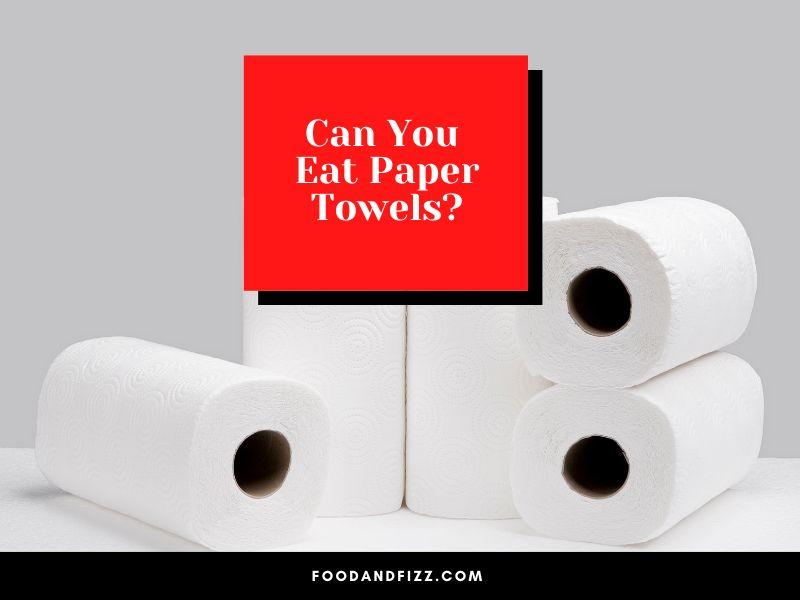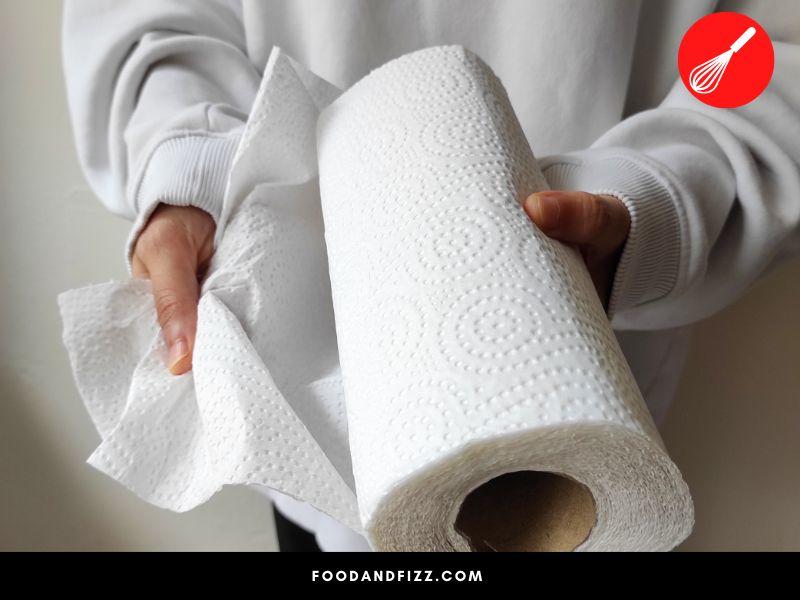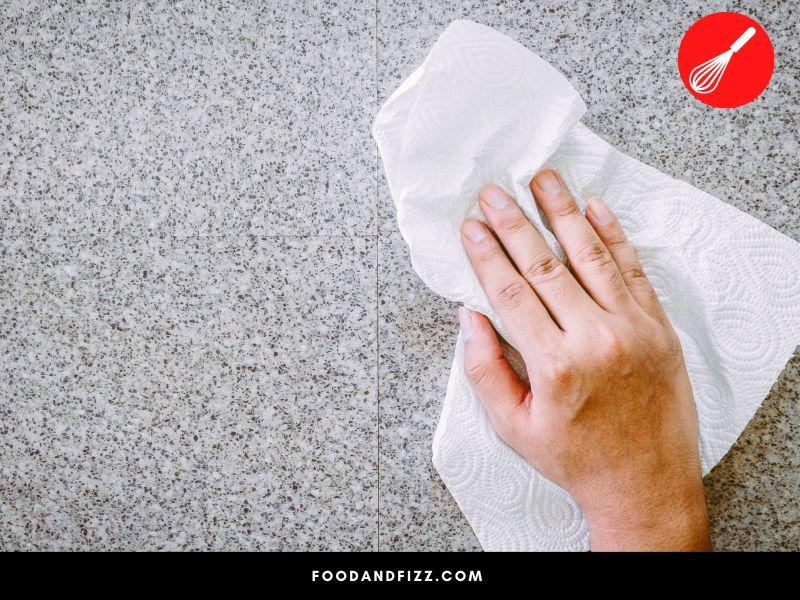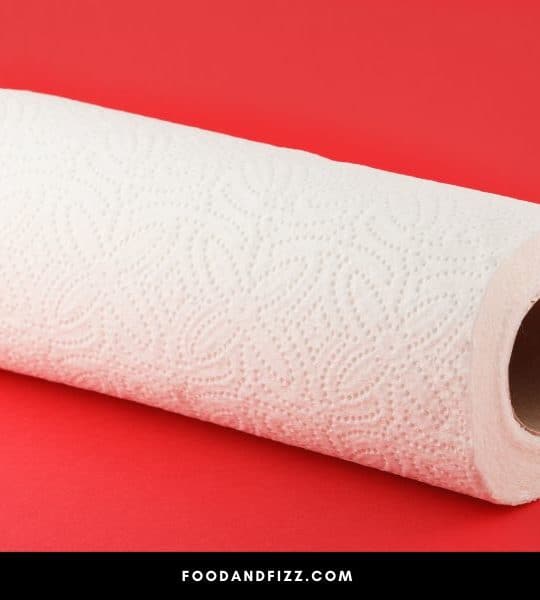Paper towels are a wonderful thing.They clean surfaces and floors, drain and dry items and hold and store food. They are thin and light, are all-purpose, and can assist you in multiple tasks in the kitchen, from preparation to cooking, to serving and cleanup.
If you can snack on them too, wouldn’t they be the single greatest kitchen invention ever?
A lot of us have wondered about this for sure, but very few have actually done it. The burning question for today is, can you eat paper towels?
Can You Eat Paper Towels?
You can eat paper towels but it would not be a good idea to do so. They have no taste and no nutritional value and are made from plant cellulose fibers that the human body cannot digest. Ingesting big amounts can cause inflammation, bloating, blockage in the digestive tract, and other health issues.

Can You Eat Paper Towels?
I’d be lying if I said I never ever wondered what paper towels tasted like, and what will happen if I eat them. However, I’ve never actually gotten to the point where I felt I needed to try them.
It could be because they just have so many uses that eating them is the last thing on my mind, or because my brain is so busy thinking about all the delicious food I want to eat that something as plain as a paper towel is just so unappealing.
Also, if they were so healthy and delicious, somebody would have said something by now, don’t you think?
But the fact is, they aren’t the greatest snack in the world. Besides the fact that they have no appealing taste, texture, and flavor, paper towels are made from cellulose – a type of insoluble fiber and complex carbohydrate that human beings do not have the ability to break down and process.
If we do not have the ability to break something down in the digestive process, that means that it will pretty much come out of us in the same form that it came in.
Granted, cellulose is fiber and we all know that fiber works wonders for our digestion. Insoluble fiber is what helps “move things along” in digestion. But too much of it can actually cause gas, bloating, and even digestive blockages.
Extreme cases may even require surgery. Certainly not a risk worth taking for something so bland and unappealing.
Aside from that, they also contain harmful chemicals that are used in their manufacturing, and as such, they are not a good idea to ingest.
Eating paper towels is not advisable for several reasons.
1. Cellulose Fibers
Cellulose is a form of insoluble fiber naturally found in trees and plants that help give plants their structure and form. It is a complex carbohydrate composed of many chains of glucose molecules.
Humans do not possess the enzymes necessary to process cellulose, unlike animals like goats and cows, who have the necessary enzymes in their digestive tracts.
As we mentioned earlier, paper towels, much like paper, are made mostly from these cellulose fibers. Ingesting these indigestible fibers in large amounts can cause irritation, gas, bloating, and inflammation and may even lead to blockage in our digestion.
2. Bleach and Other Chemicals
In the process of making paper towels, bleach and chlorine are often used to make the color of the paper towels lighter, and formaldehyde is used to make them stronger.
All these chemicals can cause harm to us when taken in large amounts, and some like formaldehyde are linked to certain cancers.
Dyes and adhesives are also used in the manufacturing process, which may have adverse health effects when consumed in large amounts.
If we eat paper towels, we ingest all these chemicals too.
3. No taste, flavor, and no nutritional value
Paper towels have no taste, no flavor, and no perceivable health benefits, so what’s the point of even eating them and subjecting ourselves to that type of disappointment?
We do not even want to eat food that is good for us if we do not like them taste-wise. What more food that isn’t good taste-wise, and isn’t good for us, too.
You can eat paper towels without much harm in small amounts, but frankly, what’s the point of doing so? There are so many more good things to eat out there that are more worth our time, attention, and taste buds.

How Are Paper Towels Made?
Brief History of Paper Towels
The paper towel as we know it today has a history that dates back to 1879 when two brothers founded The Scott Paper Company. As the years went on, this company became a well-known producer of toilet tissue paper.
In 1907, the company was faced with an issue regarding a big batch of toilet tissue paper (an entire railroad truck’s worth) that was rolled too thick and had to be discarded.
This led the president, Arthur Scott, to think of alternative uses for it so as not to suffer such a heavy loss.
He remembered an article he read in the paper some years ago about a school teacher who started handing out soft paper to kids sick with colds and the flu, as she had the idea that using cloth towels only contributed to the spread of germs. Using single-use, disposable, soft paper helped prevent the spread of disease.
Arthur Scott capitalized on this idea and made use of the supposed to be useless rolls of too-thick tissue paper and cut them into towel-sized sheets, and sold them for this purpose.
First for medical and sanitary reasons, and then eventually, in 1931, for kitchen cleaning. And the rest, as they say, is history.
How Paper Towels Are made
Paper towels are made from plant cellulose which goes through a multi-step manufacturing process before they end up in the form that we know of on our kitchen counters. The process is similar to making paper, with added steps.
We’ll briefly look at them below.
1. Making Pulp
Raw materials are harvested from the tree, the external bark is removed and the internal wood pieces are made into small pieces and churned with water and some chemical additives that help soften and separate the bonds of the wood fibers from each other.
Through a long churning process, this eventually turns into pulp.
2. Screening, Filtering, and Bleaching
This pulp is then further processed through many layers of screening and filtering to remove impurities and unnecessary particles, to make the pulp as clean and as fine as it can be to make paper, cardboard, and paper towels.
After this, bleach is added to whiten and lighten the color.
3. Refining the Consistency
The pulp is further processed and refined to prepare it for paper production. In this process, resin is also added to help strengthen the fibers and make them bond again.
Through the use of various heating and cooling machines, the pulp is also rolled out very thin so that when this bonding process happens, it will happen in the shape of paper.
4. Bonding the Pulp
Unlike regular paper, paper towels do not need to be pressed as tightly in order to maintain their soft texture. With the use of an adhesive, two soft papers or layers are bonded together to form a single sheet of paper towel.
The air pockets created between these two layers are what give the paper towel its absorbent nature, and ability to absorb liquids.
5. Creping and Embossing
The process of creping essentially means crinkling the paper through the use of a light adhesive and a machine so that it creates more holes or open areas for liquid to enter, making it more absorbent.
More than making the paper towel look pretty, the purpose of embossing is pretty much similar to creping – it adds more space to the surface of the paper towel so that it can hold more liquid, and thus be more absorbent.
So there you have it, the basic process of making paper towels. It is pretty fascinating actually, that the same paper we use for printing or writing, when processed a bit differently, can turn into something so versatile and useful in the home.

What Are the Advantages and Disadvantages of Using Paper Towels?
Paper towels are no doubt useful to have on hand, but as with anything, they do have their drawbacks. Below we’ll name some of the advantages and disadvantages of using paper towels.
Advantages
- Convenient and easy to use
- Absorbent and reliable
- Can be used for cleaning spills and messes from floors, tables, countertops (Read: “How To Prevent Grease Build Up in the Kitchen“).
- Effective for drying dishes, pans and utensils
- Can be used to drain and absorb excess oil from fried dishes
- Can be used for straining juice
- Can be used to dry meats and other food prior to cooking
- Disposable and inexpensive
- Easily available everywhere
- Can be used in other parts of the house as well
Disadvantages
- Can get expensive depending on how much you use
- Single-use and cannot be reused
- Accumulates a lot of waste
- Not very environment-friendly
- Chemicals used in paper towel manufacturing can be a cause for concern

Are Paper Towels Environment-Friendly?
Paper towels are a paper product and of course, we all know paper comes from trees. It is understandable though, to be concerned about whether we are contributing to the degradation of the environment by using paper towels.
Are paper towels environment-friendly?
Paper towels in general, are not sustainable and take a toll on our environmental resources. To make just one ton of paper towels, it takes 17 trees and 20,000 gallons of water.
That is a lot, considering that trees do not grow overnight and how easily we can consume paper towels.
There are things we can do though, to make things a little better and lessen our usage and thus lessen the impact on our planet.
Below are some tips to limit your use:
- Choose paper towel brands made from recycled paper
- Choose Bamboo Paper Towels, which are more sustainable as bamboo grows faster than other trees
- Use Swedish dishcloths, which are compostable, anti-bacterial and washable. It has been said that only one of these dishcloths can effectively be used in place of 17 rolls of paper towels.
- Microfiber cloths are reusable and great for cleanups
- Use washable mops and towels for floors and tables
- Use strainers or a rack to drain fried food of oils
- Use cheesecloth for straining juice and liquids
- Use tea towels to dry dishes and utensils
Using these alternatives to some applications can help you limit your use of paper towels, and make your home more efficient and less wasteful.
When drying meat like chicken, alternative methods may be used. Read about “How to Dry Chicken Without Paper Towels“.

Conclusion to Can You Eat Paper Towels?
Eating a small piece of a paper towel out of curiosity is unlikely to cause any harm but it is not a wise idea to add it to your daily diet.
Besides the fact that it is mostly made up of indigestible, insoluble fiber that may cause digestive issues, it has no flavor, no taste and a has a very unpleasant texture.
It can also contain harmful chemicals because of the way it is processed, which would not be good to ingest. Lastly, it is also not very sustainable.
There is an endless variety of food available out there that are more delicious, nutritious, and enjoyable to eat, that are worth allotting more stomach space for than paper towels.
Frequently Asked Questions to Can You Eat Paper Towels?
What Happens If You Eat Paper Towels?
Eating paper towels in small amounts is unlikely to cause any serious harm but consuming them in big amounts may cause gas, bloating, extreme stomach pain, and intestinal obstructions that may require surgery.
Is Eating Paper A Disorder?
Pica is the term used to refer to eating disorders that involve consumption of items that are not classified as food. Xylophagia specifically pertains to eating paper and is a form of pica.

